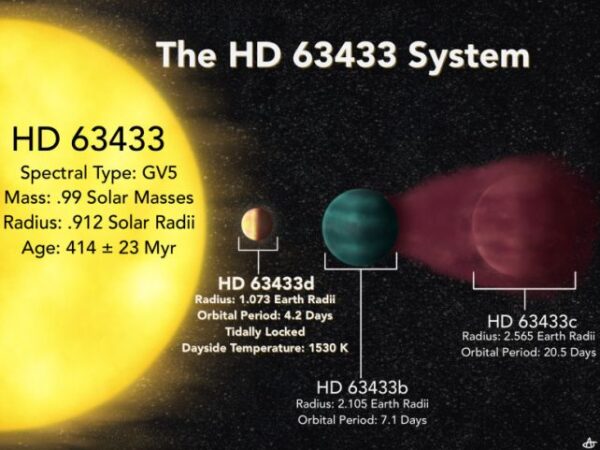
The exoplanet, discovered just 73 light-years away, allows us to see what baby Earth might look like if it were locked in a very narrow orbit with its star. The world is named HD 63433 d, a newborn exoplanet that is only slightly larger than the Earth, orbiting a Sun-like star. It is the smallest planet we have found that is less than 500 million years old, a rare window into the formation of planets that are similar to our world but not quite like it.
Earth is the only world we know to have life in. Studying the different ways Earth-like planets form and evolve, especially around Sun-like stars, helps scientists to understand the ingredients that allow life to emerge elsewhere in the universe.
HD 63433 d is at once very much like Earth and very much unlike it, which means it represents a great opportunity. And it differs from Earth in several extremely fascinating ways.
“It’s a useful planet because it might be similar to the early Earth,” says astrophysicist Melinda Soares-Furtado of the University of Wisconsin-Madison, who led the research with astronomer Benjamin Capistran of the University of Florida.
“Even though it is in very close orbit, we can use further data to look for evidence of gas emission and atmospheric loss, which could be important constraints on the evolution of terrestrial worlds. But that’s where the similarities end – and they end in a dramatic way.”
The Earth-sized world was discovered during a study using the TESS exoplanet-hunting telescope, which observes stars looking for faint, regular dips in starlight that signal the presence of an orbiting exoplanet. By measuring the various effects of an exoplanet on the light of a star, astronomers can determine its size and mass.
HD 63433 is a yellow dwarf that is almost the same size and mass as the Sun, with a similar temperature profile. But it’s much, much younger, just over 400 million years old, compared to the Sun’s 4.5 billion years. HD 63433 is, in stellar terms, just a baby; and the exoplanets that orbit it. So far, three exoplanets have been found – two mini-Neptunes spotted in 2020 and HD 63433 d.

The transit data – these incidents of light from stars during rotation – show that the radius of HD 63433 d is 1.1 times the radius of the Earth. We don’t know its mass yet, but this physical size clearly indicates an Earth-like composition, a rocky world like Earth, Mars, or Venus.
The exoplanet orbits its star in an extremely narrow orbit every 4.2 days. This means that it and its star are extremely close together, so close that HD 63433 d is probably tidally locked, with one side always facing the star. Because this hemisphere always receives the full brunt of the heat from the star, its surface is likely a constant sea of molten rock, scientists say, with a daytime temperature of 1570 Kelvin (1297 Celsius or 2366 Fahrenheit).
In fact, it is a huge ocean of lava.
The Earth, of course, has never been that close to the Sun, but it could reach temperatures of up to 2300 Kelvin after a collision that broke off a chunk of the planet to form the Moon.
There is still a lot we don’t know about HD 63433 d; the team hopes that further research will tell us a little more about it, including its mass; this in turn will allow scientists to calculate its density, which can tell us what the exoplanet is made of. We may even be able to determine whether it has an atmosphere and what it contains.
“This is our sunny yard, and it’s very exciting,” says Soares-Furtado. “What information can such a close star with such a crowded system around it provide? How will this help us when we look for planets among perhaps 100 other similar stars in this young group of which it is a part?”

